BERLIN 2004
Marianne and I spent 4 days in Berlin during the first week in May. It was the 3rd visit to that city for each of us, and has been a completely different city each time. Well, I guess everybody knows that Berlin has been through some dramatic changes: East and West Berlin separated by The Wall 1961-1989, right? Today, the wall is a tourist attraction, but if you ask some of the local Germans if we're standing in what was once East or West Berlin, they shrug and say, "I dunno, that was before my time here." It's already 15 years ago. But The Wall is still what makes Berlin like it is today, no doubt about it.
My first time was in 1966, after I'd been discharged from the US Army. I went through Checkpoint Charlie, spent a day in the frightful Deutsches Democratisches Republik, and came out glad to be a free man from the West. Everything had seemed so sad and bleak, living in ruins, just like it was supposed to. Department Stores with almost no merchandise on their shelves. Guys trying to trick me into buying them cigarettes with my dollars (for which the DDR Border Guards would bust me when I crossed back into West Berlin). On the good side, East Berlin was a great place to eat, especially for a young traveller on a tight budget with some secret black market East German Marks in his pocket. Anyway, at that time the glittering lights of Kurfürstendamm Strasse and that chromium circled three-pointed Mercedes star atop the Europa Center Building seemed to be shining proof of a much superior political system and way of life.
Next time was with Marianne in 1996, eight years ago, seven years after the Wall had fallen. Berlin was an incredible jungle of construction sites,
It was first when we foraged into the neighborhoods that had once been East Berlin that the city became charming. We were suddenly in old-fashioned Germany with Gasthauses and pretzels, where a bratwurst cost 2 Marks instead of 4. And there was a rowdy young pop culture to be had on every street, alternative shops, hand-made clothes and stuff, organic food, etc. We especially liked the easy-going counterculture shops and gemütliches old German restaurants at Hackescher Markt.
So eight years later we had a week's vacation and thought Why Not Berlin? This time we drove down in our little van, bicycles on the rack on back. We were blown away by how close Berlin actually was. We drove 2 hours from Copenhagen to the ferry terminal at Gedser, sailed for 2½ hours, then drove on another 2 hours from Rostok to Berlin. That's it, less than one tank of fuel. We intended to find a hotel in the East Berlin area this time, having learned that everything was cheaper and cozier there, and targeted the part of town called Prenzlauer Berg. It was an interesting-looking neighborhood, all right.
So we were ready to go exploring about 10:00 on our first evening, the weather was mildly warm, so we bicycled the 2 kilometers to Hackescher Markt, which we knew was our kind of place. It was great to be on bikes, last time we'd walked ourselves dead by the first day and were limping around the rest of the trip, this time we were flying through the streets! We discovered right away that Berlin was a good bike-city: there are bike paths, extra wide streets, huge sidewalks, and nobody cares what you do as long as you're careful of others. We also discovered what 8 years had done to Hackenscher Markt. The old buildings had been renovated, upgraded very nicely-- and expensively --so that the clientele was now yuppie instead of hippie. It was no longer our kind of place. However, just around the corner, was a run-down graffiti-sprayed alley with a string of taverns and restaurants time-warped from year 1966, a punk theater, techno-disco, etc. We found a comfortably shabby bar where we could sit outdoors and have a beer. A real German beer has all that foam on the top, and it takes a while to get it just right, so we had time to practice our Deutsch on the friendly bartender, which went pretty well. Marianne learned a new word: schaum, which is skum in Danish and foam in English. After the beers, it began to rain lightly so we cycled back to our hotel for the night, it was midnight by then anyway.
Our hotel was on Greifswalder Strasse, one of the main streets, with streetcar tracks running on into Alexanderplatz. We had a room on the 5th floor (no elevator), bathroom, TV and breakfast included. It was an okay place, friendly staff, and evidently a refuge for R&B bands traveling around Europe, because there were lots of autographed PR pictures in the dining room. 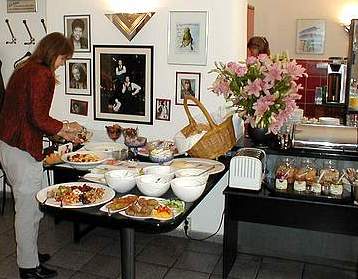 I thought it was a little expensive at 78 Euros a day, but then I don't really need the alles auf Deutsch TV, or want to pay for the same breakfast day after day. But Marianne loves it, so I just accept those conditions. You can check it out if you're going to Berlin: Hotel Greifswald Location was terrific, anyway, considering that we had bicycles.
I thought it was a little expensive at 78 Euros a day, but then I don't really need the alles auf Deutsch TV, or want to pay for the same breakfast day after day. But Marianne loves it, so I just accept those conditions. You can check it out if you're going to Berlin: Hotel Greifswald Location was terrific, anyway, considering that we had bicycles.We took a long bike ride the next day, starting out exploring the Prenzlauer Berg area, which was very much the kind of Berlin we'd been hoping to find: laid back, comfortable, lots of nice sidewalk restaurants and cafés, like Hackescher Markt had been 8 years ago. As the poor parts of town become fixed up to become the posh new rich parts of town, all the artists, hippies and cool people move out toward the yet undeveloped (cheaper) neighborhoods. First it was Kreuzberg, now it's Prenzlauer Berg, the next wave is already moving into Spandauer Vorstadt, etc. The neighborhoods around there are especially nice because most of the houses are big old buildings that had been in the time capsule that was DDR, they remained cheap and people could afford to restore them. Grand old houses with big doors, many windows, lots of rooms, high stucco ceilings, stuff like that. The whole city is also laid out with extra wide streets, a once-pompous Kaiserstadt, so there's a grand feeling of ROOM all around.
We biked onward into the biggest city park in Europe, Tiergarten. Nice and green, lots of monuments. In the smaller trails were some surprises, though. Naked men sunbathing alone, first one, then another farther on--
Heading south, we came to the Scandinavian Embassies conglomeration, which Marianne had to check out. Not that we had any embassy business to do, but it was a special building complex where Denmark, Sweden, Norway and Finland were collected together. There was a business conference going on though, so we couldn't go in without a company name tag. We were in Berlin about a week before the Danish Crown Prince was getting married, so the Danish Embassy had a display about their 1000-year kingdom, culminating with pictures of the dearly betrothed, our very own Frederik and Mary, which Marianne lapped up. (Okay... they are kinda cute.)
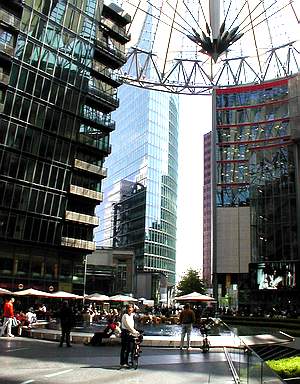 It wasn't far from there to Potsdamer Platz, which had been a great big deep hole in the ground last time we'd been here. I'd heard they'd finished it, was expecting government buildings. What we found was one of the most spectacular assemblages of cutting-edge architecture in Europe: a clump of extreme buildings tangled with one another, sharing a free-floating umbrella roof. And it all seemed to be dedicated to pleasure and entertainment-- Sony, CineMaxx, cafés, restaurants, a Film Museum, hotels, apartments, shops, etc. The film "Troy" was about to premiere at the giant CineMaxx theater, so they had a full-sized Trojan Horse parked in front, probably the same one they'd used making the movie.
It wasn't far from there to Potsdamer Platz, which had been a great big deep hole in the ground last time we'd been here. I'd heard they'd finished it, was expecting government buildings. What we found was one of the most spectacular assemblages of cutting-edge architecture in Europe: a clump of extreme buildings tangled with one another, sharing a free-floating umbrella roof. And it all seemed to be dedicated to pleasure and entertainment-- Sony, CineMaxx, cafés, restaurants, a Film Museum, hotels, apartments, shops, etc. The film "Troy" was about to premiere at the giant CineMaxx theater, so they had a full-sized Trojan Horse parked in front, probably the same one they'd used making the movie.

 We had to check out Checkpoint Charlie, of course. I'd crossed over into East Berlin there just 38 years ago, but it was hard to find anything I could recognize. Friedrichstrasse has become the high-rent district now and is totally rebuilt, a shopping street even more modern and posh than Kurfürstendamm, there's very little original slum left. Marianne found a few chunks of The Wall to take home there, you can see the elements of The Wall itself stacked up behind her.
We had to check out Checkpoint Charlie, of course. I'd crossed over into East Berlin there just 38 years ago, but it was hard to find anything I could recognize. Friedrichstrasse has become the high-rent district now and is totally rebuilt, a shopping street even more modern and posh than Kurfürstendamm, there's very little original slum left. Marianne found a few chunks of The Wall to take home there, you can see the elements of The Wall itself stacked up behind her.
We went on to find the cool part of Kreuzberg, which we never found last time, having burned out our feet by walking too much. But we didn't find it this time either, and by then we'd been biking all day and had a long ride home, so we headed back to the hotel.
We'd decided to eat dinner in the funky Thai-Chinese sidewalk restaurant located in front of our own hotel, which seemed quite popular. There was another guy sitting there when we arrived, who turned out to be the friendly bartender from the evening before at Hackescher Markt. That was a pretty funny coincidence, city of 3.5 million people, another part of town, so we started talking.
 Our next day started with a boat tour of the city, one of the best ways to see everything laid out in a row, and we were tourists, after all. It's a beautiful city, the way old traditional and daring new architectures are woven together. The tour guide spoke only German, and we both enjoyed testing our limits, finding that we understood most of it... at least until we got tired of concentrating so hard on every word, at which point we'd blur out a bit.
Our next day started with a boat tour of the city, one of the best ways to see everything laid out in a row, and we were tourists, after all. It's a beautiful city, the way old traditional and daring new architectures are woven together. The tour guide spoke only German, and we both enjoyed testing our limits, finding that we understood most of it... at least until we got tired of concentrating so hard on every word, at which point we'd blur out a bit.
It's amazing just how MUCH they've built since the Reunion of Germany, and the artistic level of all that architecture is pretty stunning. One fantastically innovative building complex after another, the new Reichstag dome, an entirely new Haptbahnhof taking shape even now, museums, culture houses, the list goes on... which was why we blurred out, I guess. It's more than you can take in at one time. After that we tried once again to find the True Kreuzberg--and DID find it, at last. And it WAS cool, very international, sorta like a back-packer's paradise: Turkish food, Thai, Indian, vegetarian, sharwarmas, tacos, pudding bars, comic book shops, etc. But by then it was almost time to meet Mirko, so we had to pedal fast back to Prenzlauer Berg. Actually, we didn't even know if the guy would show up, he'd had party plans the evening before. He had arranged to meet us at a cozy little café he knew by Kollwitz Platz, which was nice enough, although it seemed that most of the clientele were young mothers with babies. Mirko showed up right on time, but looking sleepy. We had kaffe und kuchen, like Germans do, and got a pretty interesting story out of him. Mirko was 26 when The Wall fell (he's 40 now), and had been personally involved in the East German peaceful reform movements going on back then-- glasnost, Gorbachov, remember? --which the DDR was trying to suppress. A dramatic twist being that his father was a high-ranking officer of the Stasi. He told us that there was still a lot of conflict in his family from those days.
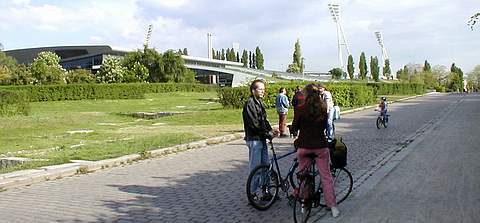
The tour continued, through lots of nice little neighborhoods with each their own platz of cafés and daily life, just so many and so much. On all the way out of town to where the deadly 100-meter dead-zone ran between the walls-- now it's a playground for children. To a tall building by the wall which was popular for making daring escapes with hooks and ropes and sliding pulleys, etc. We ended the tour at a little bar on Kastanienallee, which is yet another alternative oriented part of town. By then we were all old friends, so we traded e-mail addresses before going our separate ways. Since then, we've sent Mirko the digital pictures we took and he's just answered from Paris. Mirko travels a lot, since he works as a tourist guide. Might even visit us, who knows? You meet people when you travel.
We had our best meal in Berlin that evening, in an Italian Restaurant at the corner of Sredzki and Hagenauer strasses, a block away from Kollwitz platz. It was especially fun for me because the waiter just assumed we spoke Italian without even asking, so I did. It was outside, the evening was mild, the candlelight romantic, we were young and in love, etc. I won't bore you about what we ate-- although it was GREAT and reasonably priced. We got the feeling that most of the restaurants around there were rather like that. We checked out of our hotel next day, but drove around Berlin in our van for several hours. We wanted a better look at Kreuzberg. This was the immigrant part of town, which has so many Turks that it's called "Kleine Ankara", and was something like being in Istanbul.

We had decided to see Potsdam this day, maybe stay overnight, open plan. Potsdam is about 20 km out of Berlin and was the summer paradise for the elite among the DDR government folk. We expected decadence, and there was a phoney castle that looked like a refugee from Disneyland, but that was about it.  As it ended up, Potsdam was all right but we had seen enough after a few hours and began driving north by early evening, thinking we'd find a nice little town to spend the night.
As it ended up, Potsdam was all right but we had seen enough after a few hours and began driving north by early evening, thinking we'd find a nice little town to spend the night.But once again we were surprised at how short the distances were, so we were halway to Rostock by the time we ate dinner in a small town along the way. Wittstock is a classic little ex-DDR agricultural town, so clean and perfect that it seemed a museum piece. The only thing open was an Italian restaurant-- where once again the waiter assumed we spoke Italian, so we did. Out of curiosity, we asked if there'd been any Italians in this town back in the DDR days, but there hadn't, he'd only been there 2 years himself. After that, it was just an hour's drive to Rostock and up on the ferry 10:00 at night. We slept for the crossing and were fresh enough for those last 2 hours to Copenhagen.
3R |
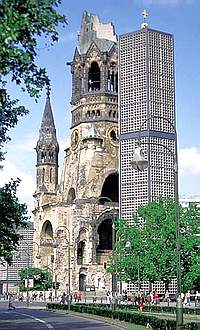 they were moving the government from Bonn, Potsdamer Platz was a huge gaping HOLE surrounded by cranes and machinery. Kurfürstendamm Strasse was still glitzy, and even more modern and Western and expensive-- and boring --as could be. The famous bombed-out shell of Gedächtnis Church was the most interesting thing for miles. It was just an extended Shopping Mall as found anywhere else in the domain of international commerce-- all the same shops and stores, the same world-reknown soda pop, the same Golden Arches. Except for the language we could have been in Copenhagen, Paris, Pasadena, Akron...
they were moving the government from Bonn, Potsdamer Platz was a huge gaping HOLE surrounded by cranes and machinery. Kurfürstendamm Strasse was still glitzy, and even more modern and Western and expensive-- and boring --as could be. The famous bombed-out shell of Gedächtnis Church was the most interesting thing for miles. It was just an extended Shopping Mall as found anywhere else in the domain of international commerce-- all the same shops and stores, the same world-reknown soda pop, the same Golden Arches. Except for the language we could have been in Copenhagen, Paris, Pasadena, Akron...
 We were lucky and found a well-hidden little hotel right away just by chance, where we could also park our van in the courtyard. I hate looking for hotels in new towns, and have given up looking for the cheapest (an old habit from my hitchhiking days), which only prolongs the search so much that you end up tired and desperate and take anything no matter how much it costs anyway.
We were lucky and found a well-hidden little hotel right away just by chance, where we could also park our van in the courtyard. I hate looking for hotels in new towns, and have given up looking for the cheapest (an old habit from my hitchhiking days), which only prolongs the search so much that you end up tired and desperate and take anything no matter how much it costs anyway. Germans also seem to be into building the most imaginative playgrounds for kids. We found ourselves taking pictures of them everywhere we went, because Marianne's a kindergarten teacher. There was always some funny new idea, some amusing twist for solving a design problem in every playground. Wooden swing sets painted and carved to resemble vegetables, forks & spoons.
Germans also seem to be into building the most imaginative playgrounds for kids. We found ourselves taking pictures of them everywhere we went, because Marianne's a kindergarten teacher. There was always some funny new idea, some amusing twist for solving a design problem in every playground. Wooden swing sets painted and carved to resemble vegetables, forks & spoons.
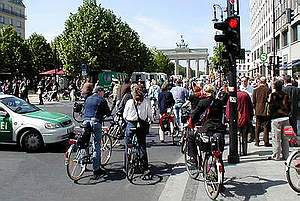 From Prenzlauer Berg we headed into the cultural center of Berlin, following Unter den Linden downtown. Just before Brandenburger Tor there was a huge demonstration in the streets, thousands of protesters as well as thousands of polizei-cars and motorcycles, because the Prime Minister of China was visiting. There were demonstrations to Free Tibet, and Falon Gong worshippers praying in the street as reminder of all their fellows killed by Chinese authorities, etc. There was no trouble whatsoever, everybody behaved like civilized people. Well-organized peaceful demonstrations go on a lot in Berlin, it's a politically conscious town.
From Prenzlauer Berg we headed into the cultural center of Berlin, following Unter den Linden downtown. Just before Brandenburger Tor there was a huge demonstration in the streets, thousands of protesters as well as thousands of polizei-cars and motorcycles, because the Prime Minister of China was visiting. There were demonstrations to Free Tibet, and Falon Gong worshippers praying in the street as reminder of all their fellows killed by Chinese authorities, etc. There was no trouble whatsoever, everybody behaved like civilized people. Well-organized peaceful demonstrations go on a lot in Berlin, it's a politically conscious town.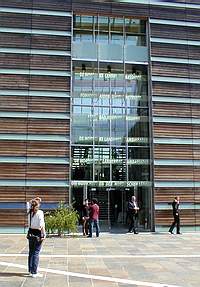 homosexuals advertising for company, it seems. We didn't stop to ask.
homosexuals advertising for company, it seems. We didn't stop to ask.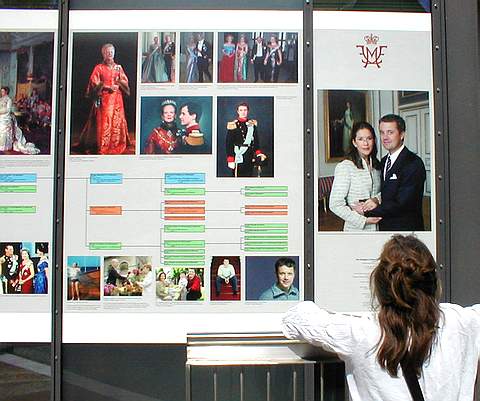
 I also did a drawing of Tazio in a giant book they have there-- page 38, I believe --so we were good tourists that day.
I also did a drawing of Tazio in a giant book they have there-- page 38, I believe --so we were good tourists that day.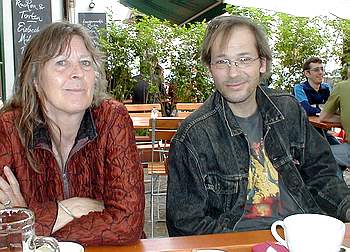 His name was Mirko and he was a real-live East Berliner, born and raised there, so we had to ask him about what it had been like living in the DDR. Other guys sat down and joined in on the conversation-- we're sitting outside at a sidewalk restaurant, you know --so we had a pretty good time. Food was good too. It ended with Mirko offering to meet us the next day and give us a bike tour of the town as he knew it, and of course we accepted.
His name was Mirko and he was a real-live East Berliner, born and raised there, so we had to ask him about what it had been like living in the DDR. Other guys sat down and joined in on the conversation-- we're sitting outside at a sidewalk restaurant, you know --so we had a pretty good time. Food was good too. It ended with Mirko offering to meet us the next day and give us a bike tour of the town as he knew it, and of course we accepted.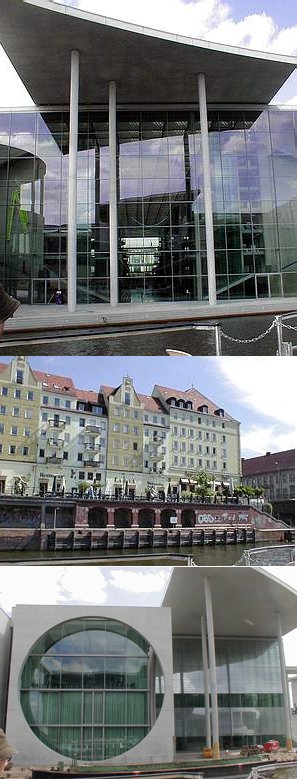 Here's some of the stuff we sailed past. > > >
Here's some of the stuff we sailed past. > > >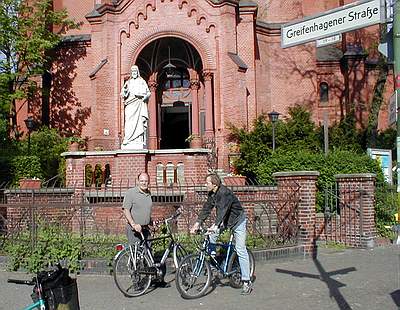 Then we went on a bike tour of the places he knew, showing us where The Wall had been, telling what it had been like before it fell. He took us to Gethsemene Kirche because that's where he had been most afraid in his life, being there among thousands of protesters when the DDR's army and police came for them, with Russian tanks leading the way. For all they knew the tanks would start using their cannons on the church.
Which didn't happen, there was too much international press on hand. In fact, The Wall would fall a month later, but no one knew that yet either. As he told us this Marianne remembered something she'd read, pulled out her Berlin guide book, checked and said, "Oh yeah, that incident is mentioned right here!"
Then we went on a bike tour of the places he knew, showing us where The Wall had been, telling what it had been like before it fell. He took us to Gethsemene Kirche because that's where he had been most afraid in his life, being there among thousands of protesters when the DDR's army and police came for them, with Russian tanks leading the way. For all they knew the tanks would start using their cannons on the church.
Which didn't happen, there was too much international press on hand. In fact, The Wall would fall a month later, but no one knew that yet either. As he told us this Marianne remembered something she'd read, pulled out her Berlin guide book, checked and said, "Oh yeah, that incident is mentioned right here!"